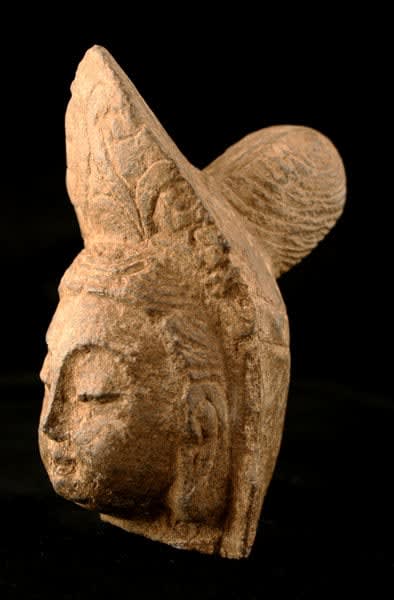Ming Stone Head of Guanyin, 1368 CE - 1644 CE
Stone
2.75 x 5
CK.0100
Further images
Upon leading a victorious rebellion against the foreign Mongul rulers of the Yuan Dynasty, a peasant named Zhu Yuanzhang seized control of China and founded the Ming Dynasty in 1368....
Upon leading a victorious rebellion against the foreign Mongul rulers of the Yuan Dynasty, a peasant named Zhu Yuanzhang seized control of China and founded the Ming Dynasty in 1368. As emperor, he founded his capital at Nanjing and adopted the name Hongwu as his reign title. Hongwu, literally meaning “vast military,” reflects the increased prestige of the army during the Ming Dynasty. Due to the very realistic threat still posed by the Mongols, Hongwu realized that a strong military was essential to Chinese prosperity. Thus, the orthodox Confucian view that the military was an inferior class to be ruled over by an elite class of scholars was reconsidered. During the Ming Dynasty, China proper was reunited after centuries of foreign incursion and occupation. Ming troops controlled Manchuria, and the Korean Joseon Dynasty respected the authority of the Ming rulers, at least nominally.
Like the founders of the Han Dynasty (206 B.C.-220 A.D.), Hongwu was extremely suspicious of the educated courtiers that advised him and, fearful that they might attempt to overthrow him, he successfully consolidated control of all aspect of government. The strict authoritarian control Hongwu wielded over the affairs of the country was due in part to the centralized system of government he inherited from the Monguls and largely kept intact. However, Hongwu replaced the Mongul bureaucrats who had ruled the country for nearly a century with native Chinese administrators. He also reinstituted the Confucian examination system that tested would-be civic officials on their knowledge of literature and philosophy. Unlike the Song Dynasty (960-1279 A.D.), which received most of its taxes from mercantile commerce, the Ming economy was based primarily on agriculture, reflecting both the peasant roots of its founder as well as the Confucian belief that trade was ignoble and parasitic.
Noted for her kindness, Guanyin is an ancient Boddhisattva. In Buddhism, Boddhisattvas are beings who have attained enlightenment, but renounce the goal of Nirvana, a state characterized by freedom from pain, suffering and the external world. Instead, these benevolent Boddhisattvas minister eternally to relieve the sufferings of all creatures, like Archangels, passing from the remote heaven to the world of men. As such, the Guanyin makes helping others toward enlightenment her mission. Originally depicted as a male in early Chinese Buddhist forms, the Guanyin eventually became associated with a local Chinese Mother Goddess, "bringer of children," and also because the gentleness and compassion of the deity suggest feminine qualities.
Like the founders of the Han Dynasty (206 B.C.-220 A.D.), Hongwu was extremely suspicious of the educated courtiers that advised him and, fearful that they might attempt to overthrow him, he successfully consolidated control of all aspect of government. The strict authoritarian control Hongwu wielded over the affairs of the country was due in part to the centralized system of government he inherited from the Monguls and largely kept intact. However, Hongwu replaced the Mongul bureaucrats who had ruled the country for nearly a century with native Chinese administrators. He also reinstituted the Confucian examination system that tested would-be civic officials on their knowledge of literature and philosophy. Unlike the Song Dynasty (960-1279 A.D.), which received most of its taxes from mercantile commerce, the Ming economy was based primarily on agriculture, reflecting both the peasant roots of its founder as well as the Confucian belief that trade was ignoble and parasitic.
Noted for her kindness, Guanyin is an ancient Boddhisattva. In Buddhism, Boddhisattvas are beings who have attained enlightenment, but renounce the goal of Nirvana, a state characterized by freedom from pain, suffering and the external world. Instead, these benevolent Boddhisattvas minister eternally to relieve the sufferings of all creatures, like Archangels, passing from the remote heaven to the world of men. As such, the Guanyin makes helping others toward enlightenment her mission. Originally depicted as a male in early Chinese Buddhist forms, the Guanyin eventually became associated with a local Chinese Mother Goddess, "bringer of children," and also because the gentleness and compassion of the deity suggest feminine qualities.









